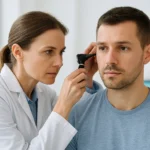
Diagnosing Blurred Vision: Key Tests and Treatment Options
Blurred Vision: A Common Symptom of Visual Acuity Issues
Blurred vision is a common symptom that can signal underlying issues with visual acuity. This condition occurs when the clarity of vision is compromised, making it difficult to see objects clearly at various distances. It may be temporary or persistent, depending on the cause.
Blurred vision can arise from both ocular and systemic conditions. These causes include:
- Refractive errors (e.g., nearsightedness, farsightedness)
- Cataracts
- Neurological conditions
The impact of blurred vision can be significant, affecting daily activities and overall quality of life.
Common Causes of Blurred Vision
Refractive Errors
Refractive errors are one of the most common causes of blurred vision. These occur when the eye does not properly focus light onto the retina, leading to unclear vision. The primary types of refractive errors are:
- Myopia (nearsightedness) – causes distant objects to appear blurry.
- Hyperopia (farsightedness) – affects the clarity of close-up objects.
- Astigmatism – results in distorted or uneven vision due to an irregular shape of the cornea or lens.
Age-Related Changes: Cataracts
Cataracts, a condition where the eye’s lens becomes clouded, are a leading cause of blurred vision, particularly in older adults. As the lens clouds over time, it can block light from passing through, resulting in hazy or dim vision. Cataracts typically develop gradually, and early symptoms may include difficulty seeing at night, glare sensitivity, and faded colors. This condition can significantly affect daily activities like reading, driving, and recognizing faces.
Systemic and Neurological Causes
Blurred vision can also stem from systemic conditions, such as diabetic retinopathy, where high blood sugar damages the blood vessels in the retina. This can lead to vision distortion or even blindness if left untreated. Additionally, neurological conditions, including stroke and multiple sclerosis, can affect the neural pathways that transmit visual information from the eye to the brain. These conditions may cause sudden vision changes, double vision, or partial vision loss, depending on the area of the brain affected.
Diagnostic Approach to Blurred Vision
Comprehensive Eye Examination
A comprehensive eye examination is essential in diagnosing the cause of blurred vision. During this exam, visual acuity tests are first conducted to assess the clarity of vision at various distances. The results help identify whether the patient has a refractive error or if the problem lies deeper in the eye. The slit-lamp examination is another key component, allowing the doctor to closely examine the structures of the eye, including the cornea, lens, and retina. This tool provides detailed insight into potential causes such as cataracts or retinal damage.
Advanced Diagnostic Tools
In addition to standard eye exams, advanced diagnostic tools are critical in assessing retinal disorders and other underlying causes of blurred vision. These include:
- Optical Coherence Tomography (OCT) – Provides high-resolution images of the retina to detect conditions such as macular degeneration or diabetic retinopathy.
- Fluorescein Angiography – Involves injecting a dye into the bloodstream to visualize blood flow in the retina, helping identify issues not visible in routine exams.
Patient History and Symptoms
Gathering a thorough patient history is essential in understanding the cause of blurred vision. Factors such as the patient’s age, medical history, and lifestyle choices can provide valuable clues. For example, a history of diabetes may point to diabetic retinopathy, while a family history of macular degeneration could indicate a higher risk for retinal issues. Additionally, understanding the patient’s symptoms-such as the onset, frequency, and duration of blurred vision-helps doctors narrow down potential causes and develop an effective treatment plan.
Management and Treatment of Blurred Vision
Corrective Lenses and Optical Interventions
For refractive errors, corrective lenses such as eyeglasses or contact lenses are the most common and non-invasive treatment. These lenses are designed to focus light correctly onto the retina, improving clarity of vision. Eyeglasses are often prescribed for individuals with myopia, hyperopia, or astigmatism, depending on the specific refractive error. Contact lenses offer a more convenient, though slightly more complex, option for those seeking clearer vision without the frame of eyeglasses.
Surgical Options for Cataracts and Retinal Disorders
In cases where refractive errors cannot be corrected with lenses, or in more severe conditions like cataracts or retinal disorders, surgical intervention may be required. Cataract surgery involves removing the clouded lens and replacing it with a clear artificial one, restoring vision for many patients. Retinal conditions, such as diabetic retinopathy or macular degeneration, may require procedures like laser surgery or vitrectomy, depending on the severity of the condition. These surgical options aim to restore or stabilize vision in cases where non-invasive treatments are insufficient.
Managing Systemic Conditions
Blurred vision caused by systemic conditions, such as diabetes or hypertension, often requires management of the underlying health issue. In diabetes, for example, controlling blood sugar levels is critical to preventing diabetic retinopathy, a condition that damages the blood vessels in the retina and leads to vision loss. Similarly, managing blood pressure in individuals with hypertension can help reduce the risk of vision complications associated with this condition. Properly managing systemic conditions through medication, lifestyle changes, and regular monitoring is crucial in preventing blurred vision from becoming a long-term issue.
Impact of Blurred Vision on Quality of Life
Physical and Social Challenges
Blurred vision can significantly impact a person’s physical and social functioning. Reduced visual acuity may make it difficult for individuals to engage in everyday tasks such as driving, reading, or recognizing faces. This can impair mobility, making activities like walking or navigating unfamiliar environments more challenging. As a result, people with blurred vision may experience decreased independence, often relying on others for assistance. Furthermore, participation in social or professional activities may be limited, affecting a person’s ability to work or interact with others in social settings.
Psychosocial and Emotional Impact
In addition to physical and social challenges, blurred vision can also lead to emotional and psychological effects. The frustration of dealing with impaired vision may contribute to anxiety and depression. Individuals may feel isolated or helpless, particularly if their condition worsens over time. This emotional burden can further reduce quality of life, making it comparable to other chronic conditions. Addressing both the physical and emotional aspects of blurred vision is crucial in helping patients maintain their mental well-being and overall quality of life.
- Refractive errors, such as myopia and hyperopia, are common causes of blurred vision, often corrected with eyeglasses or contact lenses.
- Cataracts, which affect older adults, can cause blurred vision by clouding the lens.
- Retinal disorders, including macular degeneration and diabetic retinopathy, contribute to blurred vision by damaging the retina.
- Neurological conditions like stroke and multiple sclerosis can impair vision by affecting neural pathways.
- A comprehensive eye examination is essential to determine the cause of blurred vision.
- Slit-lamp examination and fundoscopy are key diagnostic tools for detecting eye conditions that cause blurred vision.
- Common treatments for blurred vision include corrective lenses, cataract surgery, and management of systemic conditions like diabetes.
- Blurred vision can impact daily activities such as driving, reading, and social interactions.
- Blurred vision can reduce quality of life, comparable to other chronic health conditions.
- What are the common causes of blurred vision?
- Blurred vision can result from refractive errors (such as myopia and hyperopia), cataracts, retinal disorders like macular degeneration, or neurological conditions like stroke.
- How is blurred vision diagnosed?
- Blurred vision is diagnosed through a comprehensive eye examination, including visual acuity tests, slit-lamp examination, and fundoscopy. Advanced tools like OCT and fluorescein angiography may also be used to assess the retina.
- What treatments are available for blurred vision?
- Treatment options for blurred vision include corrective lenses for refractive errors, cataract surgery for clouded lenses, and surgery for retinal disorders. Managing systemic conditions like diabetes can also improve vision.
- Can blurred vision be caused by stress or anxiety?
- While blurred vision can be caused by physical conditions, stress or anxiety may exacerbate visual disturbances. It’s important to address both the physical and emotional aspects of vision problems.
- How does blurred vision affect daily life?
- Blurred vision can interfere with basic activities like reading, driving, and socializing, reducing independence and quality of life. It can also impact work and personal relationships.
- Is blurred vision a sign of a serious health problem?
- Blurred vision can be a sign of a serious health issue, especially if it’s caused by conditions like cataracts, macular degeneration, or diabetic retinopathy. Prompt evaluation by an eye care professional is crucial.
- Can blurred vision be prevented?
- While some causes of blurred vision, like cataracts or retinal disorders, cannot be fully prevented, maintaining eye health through regular exams, managing underlying conditions like diabetes, and protecting eyes from UV light can help reduce risks.
- When should I see a doctor about blurred vision?
- If blurred vision persists or worsens, or if it’s accompanied by other symptoms like pain, headache, or sudden vision loss, it’s important to see a doctor immediately for evaluation and treatment.



















